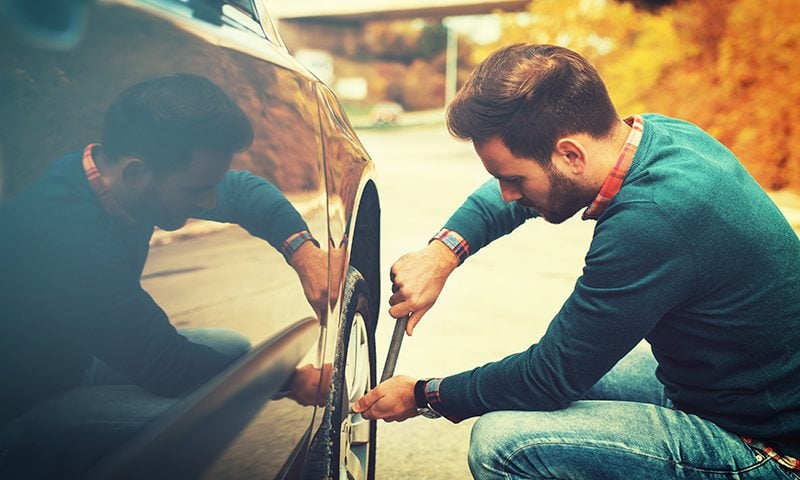We’ll never tire of good tyre advice

If you noticed that your car door wasn’t closing properly you wouldn’t leave it would you? Well, this should be the same for your tyres too. Tyres are essentially the foundation to your car and should be checked regularly.
New laws have come in whereby if your tyres aren’t fit for purpose and you get stopped, you could be looking at a £10,000 fine as well as 12 points on your licence.
If you start having difficulties on the road it’s crucial that you know these simple bits of advice by IAM RoadSmart to help you get back behind the wheel again. If you’ve just spotted one of your tyres has a puncture, you’ll probably find this particularly punctual…
Richard Gladman, IAM RoadSmart’s Head of Driving and Riding Standards, has put together some handy tips for how best to change a tyre.
Safety first
First things first, as it often is, make sure you’re safe. If you’ve got to change a tyre, make sure you find a safe place to pull over. You need to be as far away from traffic as possible.
However far from traffic you may be, you need to make other drivers aware of your tiresome tyre turmoil. Turn on your hazard lights and raise your bonnet if you can. The bonnet may not help you change the tyre, but it’s an easy way to make other drivers aware of you.
Stay grounded (and check out the floor)
Once you’ve pulled over, you need to check the ground. If it’s a little on the soft side, or a little uneven, it may not be safe for you to change the tyre yourself.
If you’re unable to relocate to a more sturdy area, it’s probably best to call a professional.
Add a step to your weekly vehicle checks
When you’re doing your weekly vehicle check, make sure you take the time to locate the jack and wheel brace. It’ll make your life a whole lot easier if you ever have to change your tyre.
And if you’re thinking ‘what weekly vehicle checks?’… it’s time to start doing some weekly vehicle checks!
Loosen the wheel nuts first
Before you even think about jacking up your car, loosen your wheel nuts. While raising the car may seem like the logical first step, it will be less stable once jacked. So loosen the nuts first to make things smoother.
Raise it higher
This one’s definitely worth remembering.
The vehicle will need to be higher to put on the new tyre than it was to remove the old. So, always raise it a little higher than you think at the start to save yourself some time.
Keep gloves handy
Gloves. If you don’t have a pair in the boot already, go and do it right now. Go on, we’ll wait.
Always wear gloves when removing the old tyre, as if there’s a puncture, there’s likely to be a sharp object somewhere nearby. Also, wheels are dirty, so stay hygienic.
When to tighten the wheel nuts
Much like loosening the wheel nuts before jacking up the car, the same principal applies when you’re bringing it back down.
IAM RoadSmart suggests that you “tighten the wheel nuts until the wheel sits squarely on the hub and then lower the jack, then further tighten the wheel nuts with the vehicle stable”. Once done, always get the wheel nuts checked over by a professional.
Give the hard shoulder the cold shoulder
Due to how close you’ll be to traffic, it’s best to not change your tyre on the hard shoulder. If you get an unfortunate motorway puncture, pull over and contact the Highways Agency for help.
The best advice we can give is ‘don’t leave your tyres until they become a problem, check them regularly and if you do notice anything a bit ‘dodgy’ head to your local garage and get them to double check/ change your tyre over’. It’s better to be safe then sorry.



6 Comments
Thank you so much for mentioning that when you check your vehicle weekly you should make sure that you also check for a jack and a wheel brace. My brother recently had a flat tire, so it made me think about what kind of situation I would be in if I were to have a flat tire. I know that I will now be looking to make sure I have a jack and wheel brace and that I know of a great tire company so I can go get a new tire if need be.
We’re happy to help 🙂
I never considered loosening the nuts before jacking up the car. It would make sense to get everything out of the way before rendering it immobile. I’ll have to remember your tips if I ever need to work on my tires.
I found it interesting when you said raising it higher is definitely worth remembering. However, I still need somebody to change it for me since I know nothing about the basic troubleshooting procedures. But yes, I will regularly check the tires for this purpose.
I like your advice on checking your cars tyres regularly for cracks. This can be a big safety hazard if you notice wearing on them. If you are planning a road trip, these are good times to take a good look as well.
Thanks for these tyre tips. I had no idea that you should look for the jack and wheel brace when it comes to weekly inspections. It sounds important to make sure these braces still work properly, in case you need to replace them.